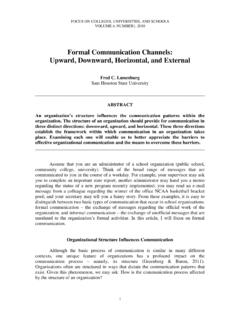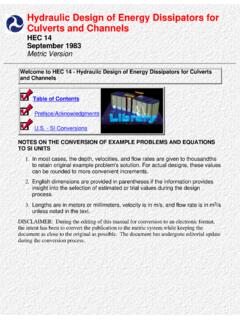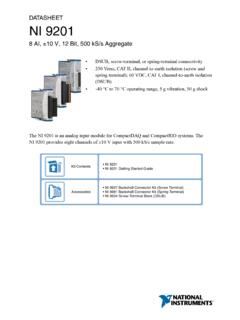Transcription of Grated Polycrete Channels - Site Installation Manual
1 ACO Civil Construction Products T TO. ION JOIN. EXPANS D ETAIL. E R 'S. ENGINE. TE. CONCRE. LAYER. BEDDING. SOIL. Grated Polycrete Channels Site Installation Manual Contents Getting Started Getting Started 2 Polycrete Channels * are a full range of modular Channels with lockable grates. Health and Safety 3. Systems include in-line pits, end caps, Installation Sections 4 and other accessories. 1 Trench Excavation 5. Polycrete Channels , when installed correctly, 2 On-Site Fabrications 6 are designed to withstand a variety of loads Non-Standard Lengths 6 classified to EN 1433, a standard specific for Curves 6 trench drain systems and AS 3996, a general Bends 6. standard for access covers and grates. Corners 7. T- Junctions 7 Polymer concrete products should be handled Polycrete Channels 3 Pipe Connections 8 with care as they can be damaged by impact In-line Pit Cut-out 8 from other products or machinery.
2 channel Knock-out 8. Core Drill / Hole Saw 9 Typical equipment and materials necessary Stitch Drilling 9 for Installation may include: 4 Connection to Drainage System 10 Grate removal tool (Part No. 01318). In-line Pit 10 Excavating equipment Vertical Outlet 10. String-line and laser level End Cap and Horizontal Pipe Connections 10 Measuring tools 5 channel Setup 11 Masonry drill, grinder, saw A. Patty Method 12 and / or hole saw B. Continuous Wet Base Method 13. Rubber mallet C. Installation Device Method 14. D. Hanging Method 16 Hammer 2. 6 Concrete Encasement 17 Concrete 25 MPa minimum channel Bracing 17 compressive strength Concrete Pour 17. Gloves, eye protection and respirator 7 Pavement Finishing 18. Concrete 18 ACO products are delivered wrapped in Asphalt 19 plastic. ACO recommends that the plastic Brick Pavers 19 is removed as soon as possible to prevent Adjacent to Wall 19 accelerated discolouration (oxidation) of Beside Kerb 19 the ductile iron components.
3 8 Fit and Remove Grates 20. QuickLok Grates 20. PowerLok Grates 21. 9 Final Inspection 22. * Polycrete Channels is ACO's trademark for products 10 Maintenance 23 made from polymer concrete. Commercial Trench Drains In-line pit with Lockable Modular rubbish basket grate channel Female end (upstream). Male end (downstream). Polycrete Channels channel sequence number Flow direction indicator arrow. Make sure the arrows moulded onto the sides of the channel all point in the direction of the intended flow. Health and Safety Polymer Concrete Products Polymer concrete products are manufactured using synthetic resin, mineral aggregates and curing agents. The main hazards include: 3. Abrasive damage to hands Inhalation of dust from grinding, cutting or drilling Grinding, cutting or drilling may project small fragments Gloves, eye protection and a respirator should be worn to avoid these hazards.
4 Metal Grates Grates made from metals are either cast or fabricated. The main hazards include: Abrasive damage / cuts to hands Inhalation of dust from grinding or cutting Grinding or cutting may generate sparks, therefore ammable items must be removed from the area Gloves, eye protection and a respirator should be worn to avoid these hazards. Operations must be conducted away from areas of fire or explosion hazard. 1300 765 226 (AUS) 0800 448 080 (NZ) +61 2 4747 4000 (EXPORT). Installation Sections Pavers AS 3996 Class A B. Pavers Installed Polycrete Channels should incorporate the following: Concrete encasement 1. Correct grate type. 2. Correct channel type and size . 100mm 3. Minimum grade 25 MPa compressive strength cement concrete encasement. Subgrade AS 3996 Load Class Encasement 100mm 100mm Dimension Polycrete Channels Class A B 100 mm Class C D 150 mm Asphalt AS 3996 Class C D.
5 Class E G 200 mm Asphalt 25mm 1. It is recommended that the concrete 4. Concrete encasement conforms to the minimum encasement dimensions shown in the table above and illustrations to the right. 150mm These illustrations are a guide for Subgrade average ground conditions only. If more than one pour is cast for the 150mm 150mm concrete encasement, they must be adequately bonded to each other 4. for structural continuity. Concrete AS 3996 Class E G. Refer to website for access to the Expansion joint to engineer's details complete set of Installation drawings. Specific site conditions may require an increase in these dimensions Concrete encasement and / or reinforcement. If in doubt, seek professional engineering advice. It is the customer's responsibility 200mm to ensure the concrete encasement is designed for the application. Subgrade Specifiers of Polycrete Channels should download ACO's Specification 200mm 200mm Design Brief from the website.
6 Commercial Trench Drains 1 Trench Excavation Mark on the ground the location of the Polycrete Channels . Excavate trench to accommodate the drainage system. Trench must be sized to include the following: A. channel / in-line pit width and depth dimensions. Neutral system 010, 010, 010, 010, 010, 010, 010, 010. B. For sloped systems, excavate base of trench to roughly follow fall of trench run. Sloped NOTE: ACO's sloped Channels have a Polycrete Channels system 3 built-in fall along the channel invert 5, 4, 6, 8, 7, (5mm fall per metre). 10, 9, C. Concrete encasement dimensions. Formwork Finished surface if required 3mm above channel Dimension for: X. x x AS 3996 Class A B 100 mm AS 3996 Class C D 150 mm See table for x dimensions AS 3996 Class E G 200 mm 5. NOTE: Check Specification Information (Spec Info) Sheets for overall product widths and depths.
7 Standard Installation drawings can be downloaded from the website. Ensure loose material is removed from the trench and the base is compacted. Set up a string-line at the finished surface level along the full length of the trench run to align with either the left or the right channel edge rail. This will ensure the drain is installed to the correct grade and longitudinal alignment. A laser level can be used to check the set height of each channel as they are laid to the string-line. Use a spirit level to check across both edge rails as each channel is laid. In concrete pavements, ensure an allowance is made for expansion joints for movement due to thermal expansion and contraction, see Section 7. 1300 765 226 (AUS) 0800 448 080 (NZ) +61 2 4747 4000 (EXPORT). 2 On-Site Fabrications Appropriate personal protective equipment (PPE) for example gloves, eye protection and respirator, should be worn when cutting Channels and grates.
8 Cutting Channels are required to form non-standard lengths, curves, bends, corners and T-junctions. These fabrications are completed on site by the installer. A 2-part rigid resin glue can be used to bond cut surfaces together. In applications where corrosive liquids are collected in the channel , joints should be sealed with a suitable chemically resistant sealant. Non-Standard Lengths Polycrete Channels Channels should be cut with a masonry saw with a diamond or masonry blade. Grates should be cut with a suitable abrasive blade. Curves Channels can be installed to slight curves by leaving an acceptable gap at the channel joints (acceptable gap to be approved by client). 6 Acceptable gap Bends For tight curves or bends, mitre cut the end off each channel and grate to the required angle. This provides a neat finish at the joint. Mitre each channel end Commercial Trench Drains Corners Channels and grates mitred Corners are formed using a mitred joint at 45 angle for 90 bend by cutting Channels and grates to the or appropriate angle to form the required bend.
9 Required angle and joining together. For load class D to G applications, mitred grates are not recommended. A butt joint is recommended as used in T-junctions. T- Junctions Polycrete Channels T- junctions or right angle joints are formed when an opening is cut into the side of one channel and another channel is butted up square to this opening. Cut opening on the side of the channel 500mm For T-junctions, all half metre Channels provide a moulded guide to aid connection. 7. Moulded guide Mark profile for T- junction To form a T-junction at a location along a channel that does not have a moulded guide, place another channel perpendicular at the proposed joint location. Mark on the channel wall the area to be cut by using the internal profile of the channel as a guide. CAUTION: Do not cut the edge rail, as it should be left intact to provide additional strength and seating for the grate.
10 1300 765 226 (AUS) 0800 448 080 (NZ) +61 2 4747 4000 (EXPORT). 3 Pipe Connections There are a number of ways to prepare channel Knock-out products for pipe connection. Bracing For Channels with knock-out symbol may be necessary. 1. Place channel on loose sandy ground In applications where corrosive liquids are to absorb impact and prevent cracking. collected in a channel , joints should be sealed CAUTION: Do not place channel on with a suitable chemically resistant sealant. concrete, rock or any other hard surfaces. In-line Pit Cut-out Use a hammer on the inside of the channel to gently tap in a circular motion around 1. To cut opening for required pipe size and the knock-out symbol as shown below. Polycrete Channels location, use a handsaw, reciprocating saw or circular saw with an appropriate cutting blade, as pits and / or pit bases can be manufactured from either polymer concrete or plastic.









